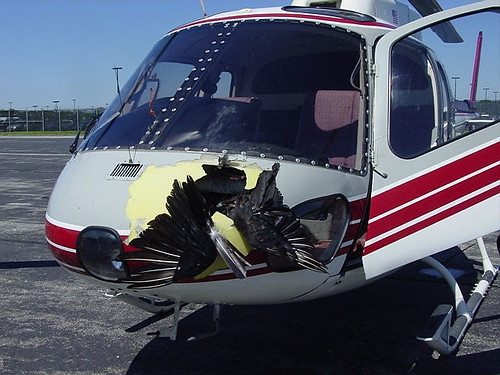Bird strikes to civil and military helicopters resulted in 61 human injuries and 11 lost lives since 1990. As with fixed-winged aircraft, bird strikes to helicopters are costly. Available data showed the average cost of a damaging strike to military helicopters ranged from $12,184 to $337,281 per incident, and APHIS-Wildlife Services (WS) wants to address this problem.
More than a dozen stakeholders representing both civil and military aviation groups, safety and regulatory agencies, and wildlife specialists turned out for the May 15th USDA-APHIS stakeholders meeting to hear results from the first scientific analysis of bird-strike hazards to helicopters.
APHIS-Wildlife Services (WS) researcher Dr. Brian Washburn and WS Airport Wildlife Hazards Program Coordinator Michael Begier presented results from the analysis that included data from all four military branches and the Federal Aviation Administration’s National Wildlife Strike Database.
“Our analysis of approximately 4,500 incidents showed the number of bird strikes to helicopters was highest during fall and lowest during winter,” states Washburn. “Also, raptors and vultures were commonly associated with the most damaging helicopter strikes.”
Researchers recommend increasing bird-strike reporting, modifying flight plans to avoid or minimize low-level flights over or near landfills and other known wildlife attractants, and reinforcing sections on aircraft that are most commonly struck and damaged (e.g., windscreens and main rotor system) to better withstand the impact of strikes with large birds.
Support for the analysis was provided by the Department of Defense’s Legacy Program. A copy of the final report “Bird Strike Hazards and Mitigation Strategies for Military Rotary-wing Aircraft” can be viewed online.
Through a balance of operational wildlife management and research, WS’ Airport Wildlife Hazards Program provides solutions to help reduce wildlife-caused damage to aviation. Through a Memorandum of Understanding (MOU) between WS and the Federal Aviation Administration (FAA) and Department of Defense (DOD) and other cooperative agreements, this program addresses wildlife conflict issues at both civil and military airfields.
In 2012, 772 airports sought assistance from WS and the program provided 232 staff-years of assistance at airports and airbases in every state as well as three U.S. territories and 6 foreign countries.

